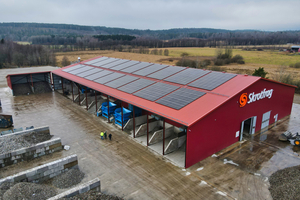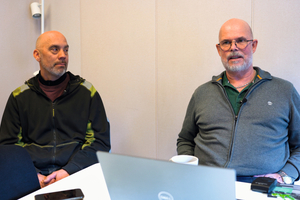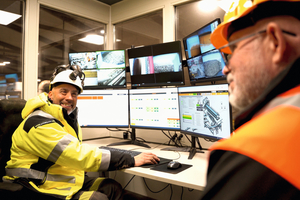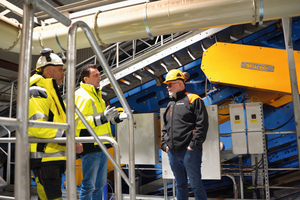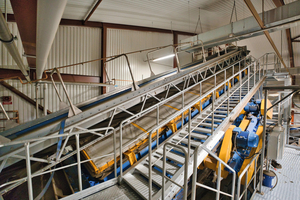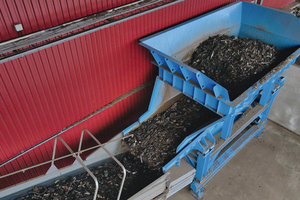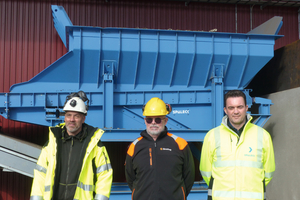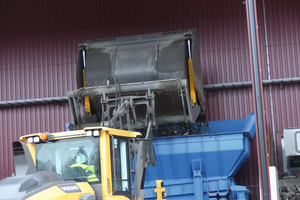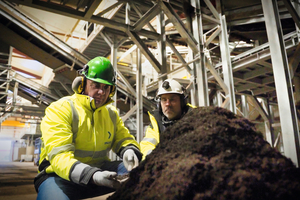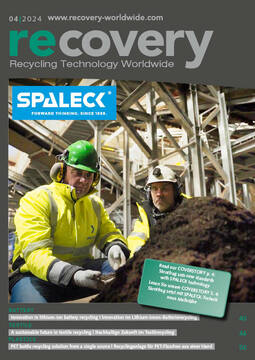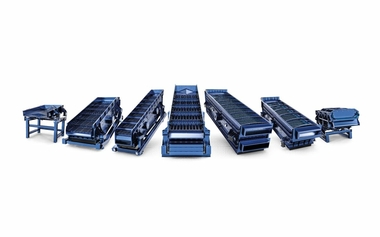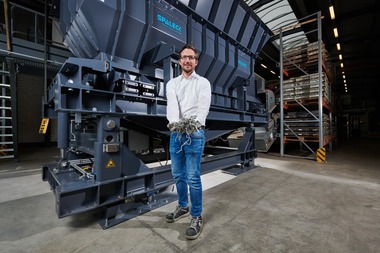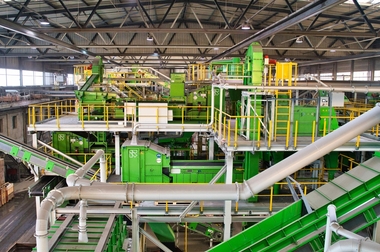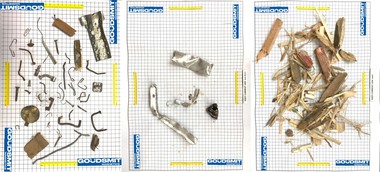Skrotfrag sets new standards in the recycling of
non-ferrous metals with SPALECK technology
Lars Johansson founded Skrotfrag in 1972 – back then the company started out in the Gothenburg region with balers for end-of-life vehicles, and soon the first scrap yards followed. A first plant for shredding cars was added in Agnesberg. Today, the company is managed by the sons Emil and Paul Johannson. They practically grew up in the company and have been working in various positions during their careers.
The Skrotfrag Group is one of Sweden‘s largest scrap and metal recycling companies with over 200 employees at 27 locations. The company operates shredders in Gothenburg and Oskarshamn. The Non-ferrous metals part of the shredded material is processed in Sjövik, among other places. “Here in Sjövik, we operate one of the three largest recycling plants for non-ferrous metal processing in Europe,“ reports Per Ola Berthelsen, Project Manager at Swedish recycling specialist Skrotfrag.
In 2008, the site was bought from a former concrete plant and in 2023, within two years, Skrotfrag built and put into operation a processing plant for non-ferrous metals (NF). It was advantageous that the plant was built from scratch, i.e. there was no need to modify or convert an existing plant. The particular challenge here was the restrictions on delivery situation of all plant components caused by the coronavirus crisis. However, despite the project manager‘s initial fears, all deadlines were met and there were no significant delivery delays. Aluminum alloys, stainless steel, copper, lead and other metals are now mainly sorted here.
“The seamless integration of all machines was important to us. When selecting the individual components, we also opted for what we consider to be the leading manufacturers in metal recycling,“ continues Per Ola Berthelsen.
Reine Bergquist, Plant Manager and sorting expert at Skrotfrag, adds: “Our approach is to delve deeper and deeper into the metal recycling process. We try to separate out as much valuable NF material with as few process steps as possible. The aim is to obtain the cleanest material possible with dry separation. The perfect interaction of our technical components helps us to achieve this.“
For the screening process, Skrotfrag opted for SPALECK and its “BEST SCREENING. BEST SORTING.“ concept. The screening machine experts are convinced that the subsequent sorting technology can only deliver the best possible results (BEST SORTING) with the help of precise screening (BEST SCREENING).
Per Ola Berthelsen, who has already worked with German screening machine manufacturer SPALECK on several projects based on his many years of experience in metal recycling, also emphasizes the importance of precise screening for the entire recycling process. “I already know SPALECK and Christian Lake from several joint projects. From my point of view, there is nothing better than SPALECK solutions in the screening machine sector. Screening quality is very important to us. The SPALECK 3D COMBI classifies our materials very precisely according to size, so that they are optimal prepared for our downstream sorting.
Thanks to the precise screen cuts, we achieve higher purity in our end products and increase our profitability.“ In NF metal processing at the Sjövik site, everything starts with the SPALECK screen. The input material is first classified very cleanly into the screen fractions 0 – 5 mm, 5 – 20 mm, 20 – 60 mm, 60 – 120 mm and the oversize >120 mm.
To do this, Skrotfrag uses a SPALECK screening machine that is unique in metal recycling in terms of size. Christian Lake: “Skrotfrag opted for our largest model of the SPALECK 3D COMBI Flip-Flow screening machine in 2021. With its size and special machine set-up, the screen was unique in metal recycling up to that point.“ From his project experience, Christian Lake reports that customers with this project size and quantity of NF material use two separate screening machines as an alternative to one large screening machine: a SPALECK Recycling Metal Screen for the 20 / 60 / 120 mm screen cuts and a SPALECK Flip-Flow Screen for the fine screen cut of 5 mm.
Reine Bergquist sums up: “Our decision to use the SPALECK 3D COMBI was exactly right. It works perfectly from day one with our high volumes. The individual screen fractions impress with their excellent size classification.“ When asked about the maintenance of the machine, Reine Bergquist adds: “We only clean the screen once a week. In particular, we look at the screen mats in the lower deck to see if, for example, bicycle spokes or copper wires have become entangled here. We also check the screen mats for damage. However, to date we have had neither a defect nor a need for spare parts.”
Powerful screening technology
The three-dimensional screening, which is already in the name of the 3D COMBI, guarantees the recycling company exact separation according to material size. “The great advantage of screening in three dimensions is that no unwanted long parts are introduced into the individual fractions. This in turn improves the sorting quality and purity of the downstream units. This effectively prevents the sorting machines from missing unwanted long parts and the individual types of material are sorted accurately into the intended fraction,“ explains Christian Lake.
The exact screen cuts are then fed to the sorting technology at Skrotfrag both online and offline. This means that individual fractions are fed directly to the downstream sorting technology, consisting of eddy current separators, sensor and x-ray sorting devices. The material classified by size that does not go directly to sorting online is processed offline at a later stage.
Efficient material feed with ActiveFEED
Skrotfrag has also broken new ground with SPALECK when it comes to material feeding. “We opted for the SPALECK ActiveFEED infeed hopper for the material feed. Together with Christian Lake, we discussed the advantages of the ActiveFEED and the opportunities for our company. Our aim was to use the best available technology. That‘s how we came up with this new type of material feed, because its concept of fully automatic and always optimal material feed convinced us with the ActiveFEED,“ explains Per Ola Berthelsen.
The company is using a total of six SPALECK ActiveFEEDs in the project: three with a capacity of 8 m³ and three with a capacity of 5 m³. “If we were to use a standard infeed hopper, we would have the disadvantage that sometimes more and sometimes less material enters the sorting process. As a result, we would have unwanted shortfalls, but also overloading of our sorting technology. This in turn would result in poorer efficiency and poorer sorting quality,“ reports Per Ola Berthelsen. “With the ActiveFEED, we can now keep the feed absolutely continuous and optimize the sorting quality. The innovative infeed hopper feeds the target sorting quantity defined by us to our sorting machines very reliably and absolutely continuously at the touch of a button. This continuous material feed from the ActiveFEED infeed hopper, paired with the precise screening by the SPALECK 3D COMBI, guarantees us the highest purity in our target fractions – especially in combination with our eddy current separators, sensor and x-ray sorting devices.“
Reine Bergquist: “The SPALECK technology also allows us to increase our effective material throughput. At the same time, we are also significantly increasing our sorting quality. This is because it prevents the sorting machines and therefore the manual sorting from being overloaded. Together with the SPALECK 3D COMBI screening machine and our ActiveFEED infeed hoppers, we have the optimum technical requirements for downstream sorting.“
Practical advantages of the ActiveFEED
The ActiveFEED offers even more advantages in practice. For example, Skrotfrag can precisely adjust the material feed depending on the availability of the hand pickers. Reine: “We can now control exactly how much material should come out at the end of the sorting process. For materials that still need manual sorting for the final quality check, for example, we can say: We have two manual pickers available in the shift, so we supply them with exactly 1.5 t of material per hour with the help of ActiveFEED. If, on the other hand, we have four people in sorting, then we can go up to three, maybe four tons. This is a significant improvement in working conditions for our colleagues in manual sorting.“
Built with the future in mind
Per Ola Berthelsen emphasizes that projects of this size are always long-term projects: “Buying the technology is easy. Building a suitable hall is too. The trick is to design the recycling process in such a way that you can get the best out of your material. To do this, you need to know your material inside out. And also the technology you use.“
A glance at Skrotfrag‘s entire plant reveals that absolute professionals were at work here. Reine Bergquist: “We have incorporated all our experience and process know-how into the implementation of the plant at this location. Every machine, every material task and every sorting step has been carefully thought out and optimally arranged. The seamless integration of the 3D COMBI and the ActiveFEEDs into our sorting process guarantees an optimum level of material purity and quality of our recycled materials.“
Skrotfrag also has plans for the future. “We are set for growth here at the site. And we can realize this growth with the existing SPALECK technology. The screening machine and our ActiveFEED infeed hoppers are designed for higher throughput. We already have expansion plans for the future to expand our sorting technology.“
SPALECK systems at the Skrotfrag site in Sjövik for processing non-ferrous metals
The SPALECK 3D COMBI screening machine sets the global standard for profitable processing and recycling. The design combination ensures optimum loosening and circulation of the product in the upper deck. The 3D screen segments guarantee a long particle-free grain size in a perfect size and without impurities for the flip-flow screen located in the lower deck. SPALECK 3D COMBI Flip-Flow-Screen Type SZWS 2.000*10.000 FS 5F
The SPALECK ActiveFEED Infeed Hopper offers optimized and uniform feeding of a wide variety of materials for recycling lines, with maximum ease of use and automatic regulation for constant performance with a capacity of 2-50 m³.
SPALECK ActiveFEED Infeed Hopper Type SFLU 1.200/1.400-250*5.100, 8 m³
SPALECK ActiveFEED Infeed Hopper Type SFLU 1.200/1.400-250*5.100, 8 m³
SPALECK ActiveFEED Infeed Hopper Type SFLU 1.200/1.400-250*5.100, 8 m³
SPALECK ActiveFEED Infeed Hopper Type SFLU 800/1.000-250*5.635, 5 m³
SPALECK ActiveFEED Infeed Hopper Type SFLU 800/1.000-250*5.430, 5 m³
SPALECK ActiveFEED Infeed Hopper Type SFLU 800/1.000-250*5.735, 5 m³
Vibrating feeders are often exposed to extreme forces and stresses. The SPALECK vibratory feeder trough is therefore designed to be very robust and durable. It can also be optionally equipped with easily replaceable wear plates made of Hardox® or similar.
SPALECK Vibratory Feeder Type SFLU 750-250*2.250
SPALECK Vibratory Feeder Type SFLU 750-250*2.250

